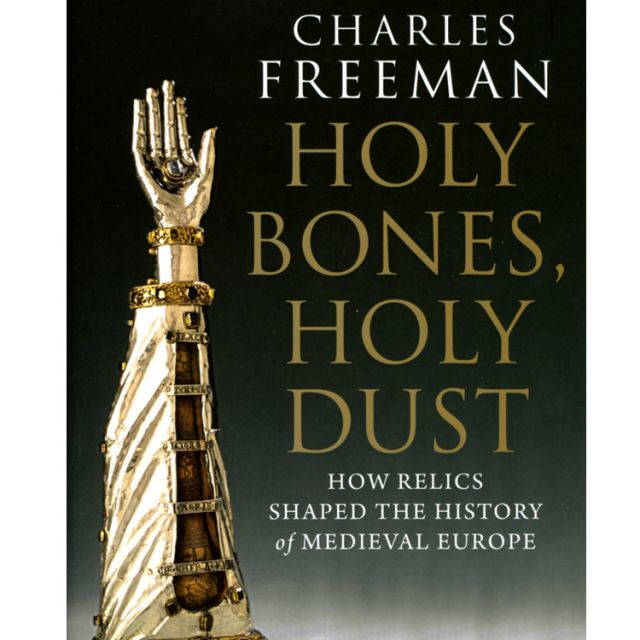The earliest veneration of relics centred on the tombs and bodily remains of the early martyrs. Over time, veneration broadened to include relics of the life and passion of Christ, such as wood of the true cross and foreskin from Jesus’ circumcision. There were also claims of relics from the Virgin Mary, Apostles and other biblical personalities, as well as saintly missionaries, monks and nuns.
Besides bones and body parts, relics included the clothing and belongings of saints, as well as objects touched by relics and onto which sanctity had been transferred. Freeman’s survey includes miraculous icons and eucharistic “relics” — in short, any miraculous object that promised access to divine assistance.
Freeman’s attempt to flesh out this story fits into the larger argument that runs through his other popular histories, especially The Closing of the Western Mind, namely that religion eclipsed the light of classical Greek and Roman reason for more than a millennium, during which time Europe groped in the darkness of superstitious irrationality, including belief in miracle-working relics. In Freeman’s account, the light of reason only glowed again in the Renaissance and finally shone forth during the 18th-century Enlightenment. The implication is that modern believers are still in the medieval gloom.
Holy Bones, Holy Dust argues that early Christian theologians, especially Ambrose and Augustine, turned their backs on elite, classical rationalism and became “obsessed” with relics and miracles. Freeman blames Augustine (354-430) for “inventing” the doctrine of original sin, according to which fallen humanity is so depraved that everyone deserves the torments of hell and can only be saved by divine grace, rather arbitrarily granted by God. Freeman repeatedly asserts Medieval people sought relief from Augustinian anxiety about their salvation through veneration of relics.
Actually, the originality of Augustine’s theory of salvation is more a matter of debate among scholars than Freeman acknowledges. Augustinian doctrine, moreover, does little to account for the zeal for relics among Byzantine Orthodox Christians, upon whom Augustine had little influence. Moreover, while pilgrims visited the shrines of saints as gestures of penance and, in the late Middle Ages, collected indulgences remitting time in Purgatory, the devotees chronicled by Freeman seemed more concerned with using relics to ward off the dangers of this life, including storms, famines, disease and enemies, than as means of escaping hell.
Freeman presents St. Ambrose of Milan (337-397) as the model for successive impresarios who manipulated devotion to relics for their own ends. Bishops controlled relics to assert their authority against competing Church leaders. Hagiographers followed custom and the expectations of their pious readers to concoct biographies of saints. Medieval townspeople mixed civic pride with devotion to their local saint. Cathedrals, monasteries and other churches traded, bought, sold and even stole relics not only to gain saintly help but also to attract streams of pilgrims and their donations. The massive gothic cathedrals were built to awe such visitors. Kings, such as St. Louis IX of France, hoarded relics as prestige items and talismans of sacred kingship.
The appetite for holy bones led to the dismemberment and dispersal of corpses and other relics. It also led to pious forgeries, some of which, such as vials of milk from the Virgin Mary, seem bafflingly ridiculous. Freeman emphasizes the strangeness of relic worship to titillate his modern readers. He reduces the motives of Medieval people to cynical self-interest, ignorant credulity or deluded fantasy. He only grudgingly acknowledges that the cult of saints inspired and supported craftsmen, artists, writers as well as marketplaces, the exchange of ideas, peace movements and charitable works.
Freeman’s underlying argument distorts the human needs expressed through the veneration of relics. But his panorama illustrates how notions of holiness changed over time in response to historical circumstances. Relics made tangible the sacred personalities and the sacred history that united Medieval people in bonds that were invisible but very real.
(Cels is Professor of History at the Athabasca University’s Centre for Global and Social Analysis.)
Tying together the history of relic worship
By Marc B. Cels, Catholic Register SpecialCharles Freeman offers a history of medieval relic worship that is both intriguing and engaging — but not, in the end, sympathetic to its subject.
Freeman ambitiously tackles the long Middle Ages — from the start of relic worship among early Christians to the Renaissance and Reformation, when the cult of saints and the reality of miracles began to be questioned. There are many relics in Holy Bones, Holy Dust, but Freeman finds few saints as he generally disparages the Medieval men and women who wrote about, built around and venerated relics.
The author deserves praise for trying to bring together into one story, spanning more than 1,500 years, the complex facets of relic worship from across Europe. Scholars specializing in medieval religion tend, instead, to focus on one area, period or cult.
Please support The Catholic Register
Unlike many media companies, The Catholic Register has never charged readers for access to the news and information on our website. We want to keep our award-winning journalism as widely available as possible. But we need your help.
For more than 125 years, The Register has been a trusted source of faith-based journalism. By making even a small donation you help ensure our future as an important voice in the Catholic Church. If you support the mission of Catholic journalism, please donate today. Thank you.
DONATE
